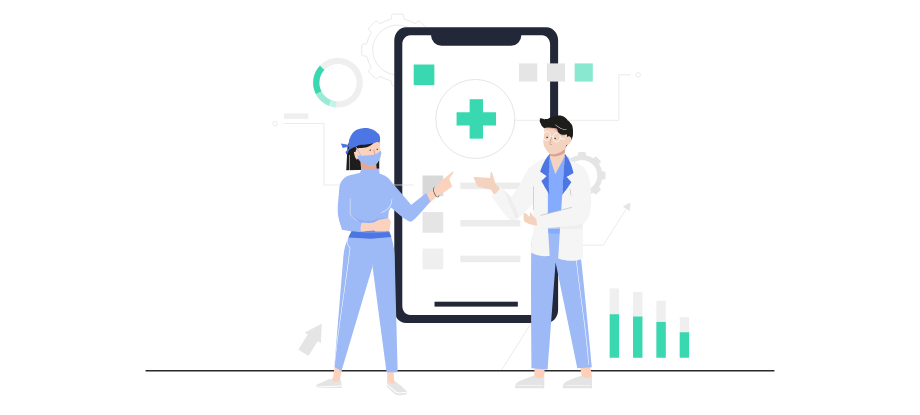Your brand is visually represented in the design of your website and apps. The UI and UX of any service, item, or product you sell must be of the highest caliber. But let’s be honest: the design typically has room for improvement, and facilitating app redesign solutions requires a skilled hand.
Did you know that 90% of website visitors leave because the site is poorly designed? It only has one meaning: if you are aware that design is your weakness, it is time to begin your redesign app journey. Therefore, if you want to keep your visual representation current, website and app redesign is a process you cannot avoid. You need to know all the relevant information for an apt redesign approach.
What Signs Might Point to The Need for a Redesign?
- You’ve undergone rebranding and want the web or app redesign to reflect the changes.
- Your conversion rate is steadily declining; you’re losing loyal customers.
- You’ve added new functionality but are unsure if they work properly.
- You want to improve your customers’ experience.
- You want to boost conversions and attract new customers.
- Your current design seems dated and does not present your business at its best.
- You want to grow customers on other platforms, such as mobile.
Why should a website or app be updated? Think of it as a hygienic routine, similar to getting your hair cut. Redesigning an app or website will improve user experience, increase customer loyalty, and boost conversion rates.
The question “Why go for a website or app redesign” is not the only one you should be asking. How to redesign a website and the methodology involved in redesigning a website are other queries.
The process of a website redesign is covered in this article. We will provide you with a step-by-step guide on an effective redesign that addresses all important website and app aspects, as well as the definition of redesign, when to start one, and why.
Guide on Redesigning Your Website
Whether it’s a corporate website or an app redesign for a financial institution, there are generally ten steps involved in redesigning a website or app. Each of them is listed below, along with a detailed explanation of why you must complete this step. This project plan template is a basic one for website redesigns.
Carrying Out an Audit
An audit involves researching and analyzing the current website, its performance, and user experience. This includes looking at user behavior, user feedback, website analytics, web or mobile app architecture, and competitor analysis. This helps to identify any potential problems or areas of improvement.
An audit is the first step in a website or app redesign that aids in product and market understanding. Without this knowledge, we cannot proceed to understand the effects of our actions.
Once the audit is complete, the team can begin creating a website or app redesign plan that considers the user’s needs and the business’s goals. This includes deciding on a design direction, creating a navigation structure, and making content and design decisions.
After the plan is finalized, the website or app redesign implementation can begin. This includes coding, testing, and launching the new website. Once the new website is running, the team can review the results and look for ways to improve the user experience.
Identifying Areas for Website Improvement
It occasionally happens that issues with a website or app have nothing to do with the design. We must confirm that the website or app redesign is required and identify additional work areas.
- Check the usability of the website or app. Make sure that users can easily navigate through the website or app with minimal effort.
- Check the content of the website or app. Ensure the information is accurate, up-to-date, and relevant to the intended audience.
- Check the performance of the website or app. Make sure it loads quickly and is optimized for various devices.
- Check the accessibility of the website or app. Make sure it is usable by people with disabilities.
- Check the security of the website or app. Ensure it is secure from malicious attacks, viruses, and other cyber-attacks.
- Check the aesthetics of the website or app. Make sure it has a consistent design and is visually appealing.
- Check the responsiveness of the website or app. Make sure it works well on different screen sizes and platforms.
- Check the analytics of the website or app. Make sure it is tracking user behavior and providing insights into usage patterns.
Defining The Redesign Strategy
Before relaunching the website, we develop the redesigning strategy and lay out the range of the work that needs to be done.
The strategy process should include the following steps:
- Evaluate the current website: Review the website or web application architecture, content, design, and usability.
- Identify goals: Analyze the website’s purpose and identify the key objectives for redesigning.
- Research the target audience: Conduct market research and user surveys to determine users’ types and needs.
- Define the scope: Identify the components of the website that need to be redesigned and set milestones for completion.
- Develop a plan: Outline the tasks, timeline, resources, and budget needed to complete the web or app redesign.
- Create a timeline: Set deadlines for milestones and create a timeline for completion.
- Monitor progress: Track the project’s progress and make changes as necessary.
Project Administration
The following should be the top priority in any plan for a website redesign: the changes must be made gradually to avoid affecting other communication channels and confusing users.
The next steps should include the following:
- Defining the scope of the web or app redesign project, including a clear timeline and objectives.
- Establishing a project team with the appropriate skills and knowledge to manage the project.
- Developing a detailed plan with a timeline for each step of the redesign process.
- Testing the website’s usability, design, and functionality to ensure it meets the project’s objectives.
- Developing a communication strategy to inform users of the redesign.
- Implementing the redesign and monitoring the results.
- Gathering user feedback and making necessary adjustments.
- Evaluating the success of the project.
Creating The Client Profile
Who is the ideal client for you? The customer profile is created at stage five to learn more about your clients’ ICPs, goals, and problems they hope to solve with your goods or services.
UI/UX
Identifying the most practical ways to improve user experience is crucial. You must do thorough research about your target audience and create a user experience that meets their needs. You should also ensure that you design your website with a focus on usability, accessibility, and responsiveness. Moreover, we would recommend you ensure that all elements of the website are visually appealing and easy to navigate.
Conducting Tests
Beta testing is essential to fully grasp how the introduced changes impact the product or service. Naturally, it delays the website or app redesign, but the result is worth the delays. Beta testing is testing a product or service before it is officially released. Generally, it involves the participation of a small group of people who are given access to the product or service in its current state and asked to provide feedback and suggestions. This feedback can be used to identify any areas of improvement or potential issues with the product or service.
The testing process should be tailored to the requirements of the product or service being tested. For example, if the website or app redesign includes new features or a different user interface, these should be tested thoroughly to ensure they are functioning as expected. Testing should also focus on how the changes impact the user experience and how easy it is for the user to navigate the website.
The feedback gathered from beta testing is invaluable for ensuring that the product or service is ready for launch. Beta testing can also provide valuable insights into how the product or service can be improved in the future.
Gathering Feedback
Always put your customers first and solicit their opinions. This knowledge will help you decide which changes to make first and how to manage a website redesign project.
Gathering feedback is an essential part of any website redesign project. It helps understand the customer’s needs, preferences, and expectations. Use this information to make informed decisions about what features or updates to add or remove. There are several ways to gather feedback. Surveys and questionnaires are the most popular tools to collect customer opinions. They can be administered online or in person. Interviews are also a great way to get deeper insights into customer preferences. Focus groups are a useful tool to get a better understanding of customer needs.
Having an open dialogue with customers is also important. Social media accounts and customer service channels offer us a platform to connect with customers and find out what they think.
Finally, analytics tools can provide detailed data about customer behavior on a website and track changes over time. This data can be used to make more informed decisions about website redesign.
Improving SEO
When working on a website or application redesign, we always consider SEO and ensure that these metrics function properly. Here are some steps you need to take into account:
- Improving website speed: Website speed is one of the most important factors for SEO. We focus on optimizing the code, leveraging caching, and using a Content Delivery Network (CDN) to deliver content quickly.
- Improving page structure: A clear page structure is extremely important in order to present content most logically and make it easier for search engine crawlers to access and index.
- Optimizing images: Use image optimization tools to compress images and reduce file size, reducing loading times and increasing page speed.
- Adding meta tags: Add meta tags to each page to provide search engines with more information about the page. This helps search engines better understand the content and improve ranking.
- Creating SEO-friendly URLs: Create SEO-friendly URLs that are easily read and descriptive of the page content.
- Increasing website visibility: Take measures to increase the visibility of our website, such as submitting sitemaps to search engines and registering for local business directories.
- Generating high-quality content: We create high-quality content that is relevant to the user’s search query and provides value. This helps to improve ranking and also increases engagement.
Conclusion
If you’re looking for a top-notch website redesign company to help reshape your apps & websites, then Golpik has got you covered! With skilled teams proficient in making your online presence stand out, you can rest easy knowing your projects are in safe hands. Whether it’s custom web application development, redesigning app facilities, or website revamps, we’ll handle it all! Get in touch to learn more!









